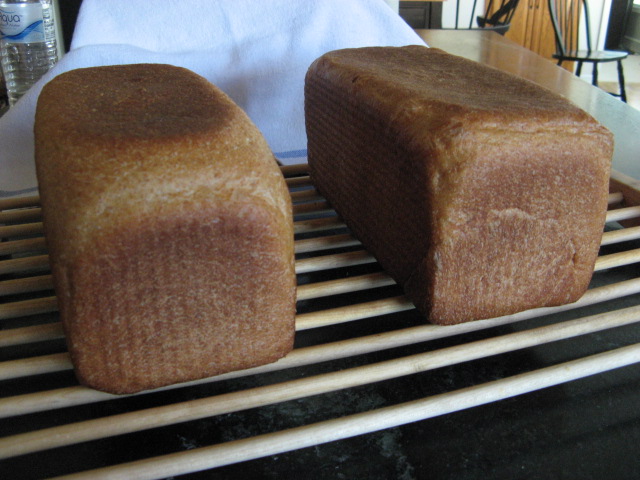This bake took place on Labor Day weekend. My pullman pans were silently mocking me from their perch in the cupboard, reminding me that the last time I used them, the loaves had ears. Or eaves. That isn't supposed to happen with pain de mie. Chalk it up to overfilling the pans.
So, this seemed like as good a time as any to experiment again. As before, I used the pain de mie formula from Hamelman's 2nd edition of Bread. In checking my previous numbers, it became evident that there was, indeed, an error in the math. Having checked the scaling factor for my 9x4x4 pans, compared to the larger ones that Hamelman uses, it appeared that 810g of dough would be appropriate for one of my pans. From that point, the rest of numbers were quickly calculated and I set to work.
This bread departs from the formula in three ways. First, it contains 50% whole wheat flour, rather than being an entirely white bread. Second, I took my first stab at using the tang zhong method, reasoning that it could benefit the texture of the finished bread. Fifty grams of flour were combined with 250g of water and cooked until it formed a soft paste or roux. Third, I substituted honey for the sugar in the formula, in equal weight.
The balance of the bread was pretty much according to Hamelman's instructions, except that I mixed and kneaded by hand instead of with a machine.
The finished bread was much better than my first attempt. Look, Ma, no eaves!:

The corners are slightly rounded. Either there should have been a few more grams of dough in the pans or it should have been allowed to proof just a bit longer. Or the shaping wasn't quite as uniform as needed. I'm leaning toward the latter, since the dough was almost touching the pan lid when the dough went into the oven.
The crumb also suggests that the dough was neither under weight or under fermented:

Despite the less-than-stellar focus, it's easy to see that there is a small zone of compaction around the sides and bottom of the loaf. It appears that the center of the loaf, which is the last to expand as the heat reaches it, has compressed the outer layer. My read is that there may actually have been slightly too much dough in the pan, though not nearly as overloaded as my first attempt. The bread was certainly easier to chew than its predecessor.
The results of the tang zhong showed up less in the form of a "shreddable" crumb and more in the form of a non-crumbly crumb that stayed moist. Achieving a wispy, ethereal crumb would probably have required twice as much time in kneading as I used. I'm happy for the way that the bread didn't dry and crumble, which whole wheat breads are prone to do.
For next time, then, a small reduction in dough quantity, keep the tang zhong, and work on shaping for more end to end uniformity. I'll probably also drop the oven temperature by 25-50F from Hamelman's recommendation. Although he is known for his preference for deeply colored crusts, my opinion is that less is more for a pain de mie style bread crust.
Paul
- pmccool's Blog
- Log in or register to post comments
like the 50% WW, and the Tang Zhong , the hand development and other future changes to the temperature too. Nice to see someone else can follow the recipe as well as my apprentice:-)
This is a great sandwich bread perfect for any lunch.
happy baking Paul!
when I chose this bread, dab. Plus the opportunity to figure out the pullman pan loading.
The other thing that I need to look at for future bakes is whether or not I can work in an autolyze. The tang zhong tied up enough of the water that I didn't bother this time. Which, I suppose, means that I need to work out the optimal amount of flour and water to commit to the tang zhong to get the desired results.
I followed the directions faithfully on the first bake, which gave me license to play around this time. Your apprentice is probably acquainted with that approach.
Paul
I'm a sucker for pain de mie. How was the hand kneading? You maybe just answered a question I have been almost asking. What is that compaction particularly at the bottom for panned loaves. I just made my usual borodinsky and the crumb was beautiful except for a half inch on the bottom. Is it really the middle pushing the edges? -Varda
Mostly slap and folds, with a few intervals of the old push-turn-fold-push method over 8-10 minutes. Although I'm not a fan of long kneads, I should give it a try to see the effect on the crumb.
It seems to me that the dough nearest the pan surfaces has an early expansion, since it is first affected by the oven's heat. Then, as the heat penetrates further into the loaf, the core is the last part to expand and crushes the still-soft outer band of the crumb. That's my theory, anyway.
One of these days I'll hit the right combination of factors to give an even crumb all the way across the loaf and fill out the corners, too.
Paul
What an attractive pair of loaves, Paul! I agree on the need for added kneading time and lower temperature. That is an excellent whole wheat pan de mie, nonetheless.
-Khalid
I'll try the longer kneading time on the next batch to see what that produces. It certainly can't hurt anything.
Paul
Nice looking bake Paul. It's always fun to take a recipe and pout your own spin on it and end up with something as pleasing as this bake.
Regards
Ian